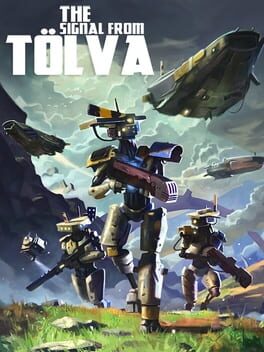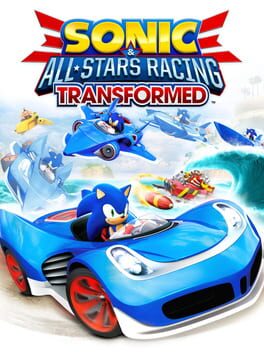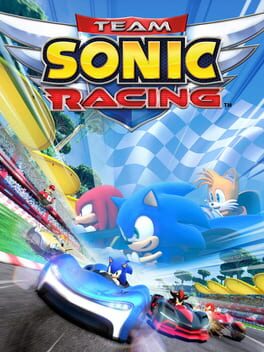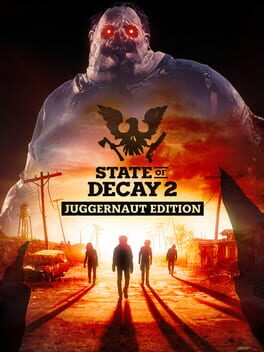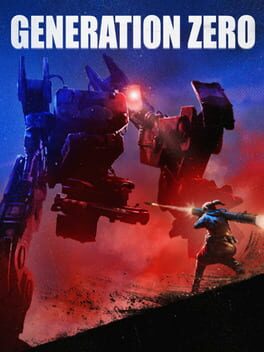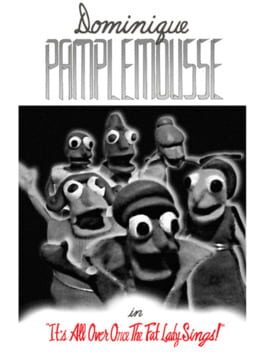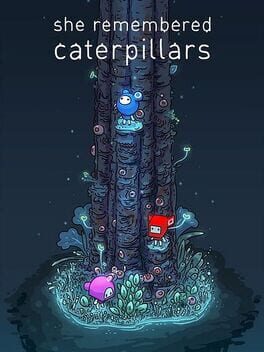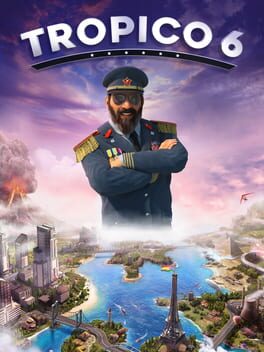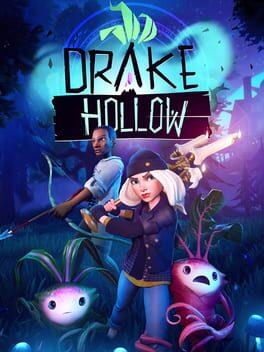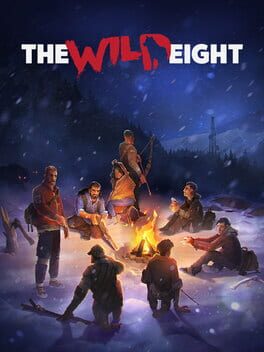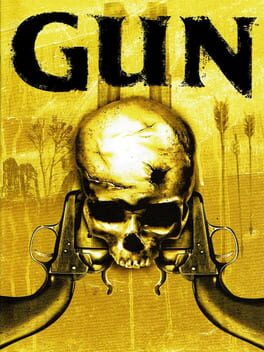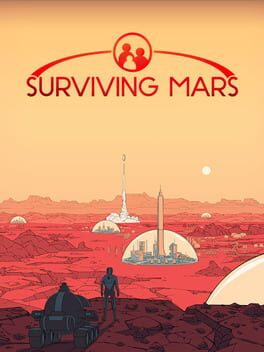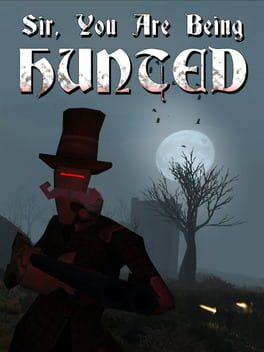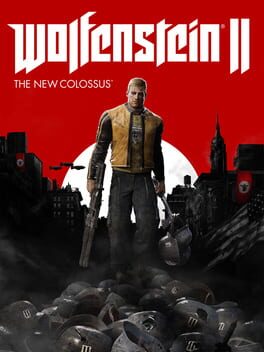astarrgames
This game is decent. I enjoyed it but had my problems with it. I read from a couple of people who did the same thing as me, which was trying it out for a couple of hours and then set it aside for months. When I finally got back into it, I actually really appreciate it with some minor criticisms that may completely turn others off of the game. I've played for about 10 hours, but could have been finished a lot earlier if I weren't hunting achievements, and even then felt like I could have been finished with it a little earlier.
The on-boarding for this game isn't that great. After an hour or two of starting the game, I didn't know who I was, what I was doing or why I was doing it. After realizing that there are pretty much three mission types (control point, scan an area, and find the hidden objects), as well as what mechanics you have available (shield, aoe, and scan) it clicked for me and I started to enjoy it.
The Signal From Tölva is very close to being a walking simulator but is definitely a first-person shooter. I really enjoyed Sir, You Are Being Hunted by the same developers, which is a stealth/walking simulator that some aspects carried over into TSFT.
The walking in this game is interesting, much like SYABH, Big Robot LTD does a pretty good job with making an open environment interesting to walk through. They do this well by making menacing structures and landscape in the distance, with interesting stationary pieces with pretty decent graphics and the possibility of some hostiles in the distance to watch for. Walking actually makes me feel like a clunky robot that is glitching out.
The landscape looks very minimal, but not bad. It does feel kind of empty, but in the sense that they purposely created a strange, empty, alien landscape that has a story behind every structure or craft that crashed on the land. The lighting and visuals are very well done, and add to the effect of making you feel like that buggy robot that has scrambled vision, or is shifting its optics to a scan mode. The audio from the ambience, robots and music is very appropriate and pleasant. There's some kinds of "life" on the planet that you hear coming and going, and the robots will chatter with one another similarly to SYABH. The music fits the moods, and that despite being a low-fi, down-temp kind of synth music, it doesn't feel repetitive or abrasive, and it does escalate with the scenario.
Then the negatives. The walking feels tedious, especially if you're not sure where you're going, or you know you'll be travelling through the same terrain to complete an objective or after a respawn. It feels tedious because the land can be difficult to traverse, with clipping problems if you try to climb or squeeze between objects, and big, empty spaces with a few rocks placed in it. Thankfully, there's no jumping puzzle or collectibles/mission items that were in inaccessible areas, because there's always a clear path to follow through the map.
Coming off of SYABH, I'm surprised by the lack of enemy diversity. There's really robot humanoids that have about 3 models, as well as flying drones, stationary turrets and moving turrets that only appear during scripted events. In SYABH, you're introduced to different types of enemies, that gradually increase in difficulty, size, and behaviours. In TSFT, the enemy difficulty increases because the 3 models of robots carry different guns and appear in increased numbers.
The story wasn't too interesting to me, but it did leave off with a decent question. I didn't feel a connection to my robots or faction, and it was probably because the banter I received from anyone else was minimal. Even then, the instructions you receive from your robot boss isn't much, and usually expresses the same information you already know. It would have been great to hear more from robots around you, because the robot banter is great. The codex that tells the story is decent, with some humour thrown in, but I didn't really feel obliged to read each entry. That may be my own personal taste, but I still enjoyed the game regardless of not being invested into the plot.
Finally, the first person action of this game can be great, or mediocre. To start, there are about 5 different types of weapons, including the usual arsenal of a pistol, assault rifles, and sniper rifles. The other two types are a streaming beam weapon and a robot controller, which are both actually pretty neat and add to the styles of shoot-outs you can get into. The action is great when you're trying to take a control point, and suddenly a group of allies pop in to help out, then the enemies get their own backup, and the fire fight escalates dramatically which feels like the FPS it should be. However, I found that I picked my two favourite weapons, and every encountered felt the exact same: snipe the enemies, activate their shields, cover until they get close, jump out to perform an AOE and rifle the rest down. Nothing encouraged me to change this style of fighting, except a brief stint of controlling robots and sending them into fight, but that was not sustainable in certain regions.
Even then, I really enjoyed my time with this game and recommend it. Although, I really recommend watching some gameplay, because this will be 50-50 between the aesthetics of the planet and how a shoot-out will usually go. I do want to say that this game is very well made, and feels like an indie that can really compete against AA or even some AAA titles.
The on-boarding for this game isn't that great. After an hour or two of starting the game, I didn't know who I was, what I was doing or why I was doing it. After realizing that there are pretty much three mission types (control point, scan an area, and find the hidden objects), as well as what mechanics you have available (shield, aoe, and scan) it clicked for me and I started to enjoy it.
The Signal From Tölva is very close to being a walking simulator but is definitely a first-person shooter. I really enjoyed Sir, You Are Being Hunted by the same developers, which is a stealth/walking simulator that some aspects carried over into TSFT.
The walking in this game is interesting, much like SYABH, Big Robot LTD does a pretty good job with making an open environment interesting to walk through. They do this well by making menacing structures and landscape in the distance, with interesting stationary pieces with pretty decent graphics and the possibility of some hostiles in the distance to watch for. Walking actually makes me feel like a clunky robot that is glitching out.
The landscape looks very minimal, but not bad. It does feel kind of empty, but in the sense that they purposely created a strange, empty, alien landscape that has a story behind every structure or craft that crashed on the land. The lighting and visuals are very well done, and add to the effect of making you feel like that buggy robot that has scrambled vision, or is shifting its optics to a scan mode. The audio from the ambience, robots and music is very appropriate and pleasant. There's some kinds of "life" on the planet that you hear coming and going, and the robots will chatter with one another similarly to SYABH. The music fits the moods, and that despite being a low-fi, down-temp kind of synth music, it doesn't feel repetitive or abrasive, and it does escalate with the scenario.
Then the negatives. The walking feels tedious, especially if you're not sure where you're going, or you know you'll be travelling through the same terrain to complete an objective or after a respawn. It feels tedious because the land can be difficult to traverse, with clipping problems if you try to climb or squeeze between objects, and big, empty spaces with a few rocks placed in it. Thankfully, there's no jumping puzzle or collectibles/mission items that were in inaccessible areas, because there's always a clear path to follow through the map.
Coming off of SYABH, I'm surprised by the lack of enemy diversity. There's really robot humanoids that have about 3 models, as well as flying drones, stationary turrets and moving turrets that only appear during scripted events. In SYABH, you're introduced to different types of enemies, that gradually increase in difficulty, size, and behaviours. In TSFT, the enemy difficulty increases because the 3 models of robots carry different guns and appear in increased numbers.
The story wasn't too interesting to me, but it did leave off with a decent question. I didn't feel a connection to my robots or faction, and it was probably because the banter I received from anyone else was minimal. Even then, the instructions you receive from your robot boss isn't much, and usually expresses the same information you already know. It would have been great to hear more from robots around you, because the robot banter is great. The codex that tells the story is decent, with some humour thrown in, but I didn't really feel obliged to read each entry. That may be my own personal taste, but I still enjoyed the game regardless of not being invested into the plot.
Finally, the first person action of this game can be great, or mediocre. To start, there are about 5 different types of weapons, including the usual arsenal of a pistol, assault rifles, and sniper rifles. The other two types are a streaming beam weapon and a robot controller, which are both actually pretty neat and add to the styles of shoot-outs you can get into. The action is great when you're trying to take a control point, and suddenly a group of allies pop in to help out, then the enemies get their own backup, and the fire fight escalates dramatically which feels like the FPS it should be. However, I found that I picked my two favourite weapons, and every encountered felt the exact same: snipe the enemies, activate their shields, cover until they get close, jump out to perform an AOE and rifle the rest down. Nothing encouraged me to change this style of fighting, except a brief stint of controlling robots and sending them into fight, but that was not sustainable in certain regions.
Even then, I really enjoyed my time with this game and recommend it. Although, I really recommend watching some gameplay, because this will be 50-50 between the aesthetics of the planet and how a shoot-out will usually go. I do want to say that this game is very well made, and feels like an indie that can really compete against AA or even some AAA titles.
It's a really good arcade racer!
It's a very forgiving racing game too. I've done a lot of split-screen gaming with someone who doesn't game or even use controllers very much, and compared to other kart games, it wasn't frustrating. Common problems with new players in arcade racers is that it's easy to spin out or take a corner and go the wrong way. There's a few things happening in here that prevent that, and some invisible wall guidance to push people back on track. There's also a very nice assistance for flying. There are a couple of choke points we've had with progression, like the "pursuit" challenges where you have to finish a lap in a certain time.
For someone who's played a lot of arcade racing games and is looking for a fun and challenging experience, this has it too. While the easiest mode is a breeze, the higher challenges improve the AI where they will actually use items properly, drift and use other mechanics to their advantage. It forces the player to learn maps and proper techniques with the cars. There are enough modes to keep the game entertaining and replayable, and it is really easy to invite friends in for local coop or remote play.
Aesthetically, it's a Sega/Sonic 3D game with lots of callbacks, bright colours, and pretty designs. Some sounds and voice lines can be silly, but at least the music has been done in a way where the loops don't feel too repetitive or annoying.
It's great! It's also pretty cheap! If you're looking for an arcade racer to get a few friends together for, this is probably it.
It's a very forgiving racing game too. I've done a lot of split-screen gaming with someone who doesn't game or even use controllers very much, and compared to other kart games, it wasn't frustrating. Common problems with new players in arcade racers is that it's easy to spin out or take a corner and go the wrong way. There's a few things happening in here that prevent that, and some invisible wall guidance to push people back on track. There's also a very nice assistance for flying. There are a couple of choke points we've had with progression, like the "pursuit" challenges where you have to finish a lap in a certain time.
For someone who's played a lot of arcade racing games and is looking for a fun and challenging experience, this has it too. While the easiest mode is a breeze, the higher challenges improve the AI where they will actually use items properly, drift and use other mechanics to their advantage. It forces the player to learn maps and proper techniques with the cars. There are enough modes to keep the game entertaining and replayable, and it is really easy to invite friends in for local coop or remote play.
Aesthetically, it's a Sega/Sonic 3D game with lots of callbacks, bright colours, and pretty designs. Some sounds and voice lines can be silly, but at least the music has been done in a way where the loops don't feel too repetitive or annoying.
It's great! It's also pretty cheap! If you're looking for an arcade racer to get a few friends together for, this is probably it.
2019
I'm not a big fan of racing games, but recently picked up a lot of arcade racers including all of the Sonic Racing titles. This is by far my favourite and I would argue best in the series. I've played this strictly in couch co-op, so I can't write to the online play. Although I find this to be a very well made and fun cart racer, it's biggest hurdles are accessibility.
The progression of development from Sonic & Sega All-Stars Racing to Sonic & All-Stars Racing Transformed to this is very noticeable. Comparing it to other character cart racers (Mario, Garfield, Crash, etc.) makes more sense than an arcade racer. This is because customization is minimal, unlockable car mods that impact a few statistics, and the dependency on external parts of the race - what items you receive, how you used them, and what environmental effects are interfering with you and the other racers.
These aren't bad things! The game plays very well, coming out of two racers that were already well designed. That is, the drifting feels nice and the car statistics actual do impact handling, and every track is significantly different and they make sense beyond just theme- or skin-changes. The difficulty with this one seems to be ramped up; even on the easiest mode you're moving fast and other racers are utilizing their items more efficiently. As well, position swapping can be so instantaneous, where someone in first can easily drop to 5th or below because they hit a wall or were hit by the right items, and subsequently, position 12 can seem to boost up to position 5 just from hitting a few boosts or getting the items they need. It's designed so items and the environment can have such a large impact on the race.
You'll figure out what tracks you love and hate easily because of their appearance and environmental effects. This is where accessibility is a huge problem against the other Sonic racers. One common complaint I'm seeing is that is that it's more difficult to see and analyze what is happening on your screen. In some levels, the track appears as a "lighter brown" against a "darker brown" of the off-track hazards, or a "lighter blue" to a "darker blue" and so on. This issue is amplified by the fact that there is so much going on - vehicles have glowing effects, multiple items make different effects, everyone's getting and using items, the environment has so many moving parts, every racer is emoting something, there's a bright yellow line behind your teammates, and there's rings everywhere. At certain points, this game looks like a neon bullet hell but in the racing genre, which hinders the actual racing of this racing game.
I grew up with Sonic, played all of the Genesis games, and watched the cartoons in the 90's. Still, most of these characters are new to me and their banter is annoying. I don't think this would be just because I haven't been following the franchise, but it feels written for a much younger generation, and the story is so elementary and repetitive, I can't even bare to watch a second of the cut scenes. It's confusing how these aspects on the game feel so childish, but the gameplay itself is so difficult and complex.
This is a busy cart racer, moreso than just about everything else in its genre. However, it tends to handle it very well with some settings to help, but not enough to make it accessible to everyone. Watch a few playthroughs, or really dive into it before your refund period expires, because if you have difficulty distinguishing some colours of the track apart - including when rockets, boulders, and fire are shooting around everywhere, then this may not be as fun for you.
The progression of development from Sonic & Sega All-Stars Racing to Sonic & All-Stars Racing Transformed to this is very noticeable. Comparing it to other character cart racers (Mario, Garfield, Crash, etc.) makes more sense than an arcade racer. This is because customization is minimal, unlockable car mods that impact a few statistics, and the dependency on external parts of the race - what items you receive, how you used them, and what environmental effects are interfering with you and the other racers.
These aren't bad things! The game plays very well, coming out of two racers that were already well designed. That is, the drifting feels nice and the car statistics actual do impact handling, and every track is significantly different and they make sense beyond just theme- or skin-changes. The difficulty with this one seems to be ramped up; even on the easiest mode you're moving fast and other racers are utilizing their items more efficiently. As well, position swapping can be so instantaneous, where someone in first can easily drop to 5th or below because they hit a wall or were hit by the right items, and subsequently, position 12 can seem to boost up to position 5 just from hitting a few boosts or getting the items they need. It's designed so items and the environment can have such a large impact on the race.
You'll figure out what tracks you love and hate easily because of their appearance and environmental effects. This is where accessibility is a huge problem against the other Sonic racers. One common complaint I'm seeing is that is that it's more difficult to see and analyze what is happening on your screen. In some levels, the track appears as a "lighter brown" against a "darker brown" of the off-track hazards, or a "lighter blue" to a "darker blue" and so on. This issue is amplified by the fact that there is so much going on - vehicles have glowing effects, multiple items make different effects, everyone's getting and using items, the environment has so many moving parts, every racer is emoting something, there's a bright yellow line behind your teammates, and there's rings everywhere. At certain points, this game looks like a neon bullet hell but in the racing genre, which hinders the actual racing of this racing game.
I grew up with Sonic, played all of the Genesis games, and watched the cartoons in the 90's. Still, most of these characters are new to me and their banter is annoying. I don't think this would be just because I haven't been following the franchise, but it feels written for a much younger generation, and the story is so elementary and repetitive, I can't even bare to watch a second of the cut scenes. It's confusing how these aspects on the game feel so childish, but the gameplay itself is so difficult and complex.
This is a busy cart racer, moreso than just about everything else in its genre. However, it tends to handle it very well with some settings to help, but not enough to make it accessible to everyone. Watch a few playthroughs, or really dive into it before your refund period expires, because if you have difficulty distinguishing some colours of the track apart - including when rockets, boulders, and fire are shooting around everywhere, then this may not be as fun for you.
I played solo, which was probably a determent to the game. I played through two maps and increased the difficulty between them. I also think I came in after a couple of quality-of-life updates, which I looked up and it seemed like this was the right time to play it.
It's a very well-designed zombie game that has great mechanisms in place to escalate the feelings of dread, desperation and endless, uphill battle a zombie apocalypse should feel like. It has great a community and base-building aspect that adds to this, where infighting and sacrifice are necessary and important parts to survival.
However, it's pushing against repetition, after two maps I considered myself finished with the game. The changes to the environment, where to build a base or take resourceful locations, alongside the limited zombie and mission types, there's not much to force a change of gameplay or encourage me to increase difficulties and start a new community in another map.
It's a very well-designed zombie game that has great mechanisms in place to escalate the feelings of dread, desperation and endless, uphill battle a zombie apocalypse should feel like. It has great a community and base-building aspect that adds to this, where infighting and sacrifice are necessary and important parts to survival.
However, it's pushing against repetition, after two maps I considered myself finished with the game. The changes to the environment, where to build a base or take resourceful locations, alongside the limited zombie and mission types, there's not much to force a change of gameplay or encourage me to increase difficulties and start a new community in another map.
2015
This review contains spoilers
I had this on my wishlist forever since finishing the Dead Island series, and picked it up on the really cheap anniversary sale. It's a big improvement in their zombie games and I'll be replaying this one a lot.
The gameplay is amazing. Zombies and human enemies are a bit diverse in their attacks and behaviours. The missions aren't repetative and there's a lot of replayable ones to pick up with and without other people online. The nightmare mode and New Game + modes really change the game and encourage replayability. I went from one-shotting groups of 8 zombies, to making it a strategic effort to even attempt a swing at a lone one, because of how the harder modes change the gameplay.
The story-line is decent despite being cliché at times, from [spoiler] the "love" story, rogue agent, recurring super villian and corrupt government stuff [/spoiler]. Customization is very limited (except they introduced 3 new bulky dudes to play as), but at least the world around you has interesting, funny and frustrating characters that make you really empathize or hate them.
After playing the end of game of this for hundreds of hours, one thing that does bug me is the sound design. There's a few ambient sounds that mimic local audio triggers, like a door breaking or an infested charging at you. While the end game on New Game + adds almost endless charging zombies, it's good to actually know when and where the attacks are coming from based on cues. This can be kind of confusing and frustrating.
The thing that really gets me excited is the parkour. It'll be impossible to go back to any kind of one-level map design where I can't even jump from rooftop to rooftop. The things that really make me anxious and frightened were the climbing missions, especially when the zombies are capable of escalating from mindless, wandering husks to intensely fast and climbing hunters. I find myself breaking sweats and needing to take breathers while climbing cranes to skyscrapers to antennas.
Get it, because this game is really great.
The gameplay is amazing. Zombies and human enemies are a bit diverse in their attacks and behaviours. The missions aren't repetative and there's a lot of replayable ones to pick up with and without other people online. The nightmare mode and New Game + modes really change the game and encourage replayability. I went from one-shotting groups of 8 zombies, to making it a strategic effort to even attempt a swing at a lone one, because of how the harder modes change the gameplay.
The story-line is decent despite being cliché at times, from [spoiler] the "love" story, rogue agent, recurring super villian and corrupt government stuff [/spoiler]. Customization is very limited (except they introduced 3 new bulky dudes to play as), but at least the world around you has interesting, funny and frustrating characters that make you really empathize or hate them.
After playing the end of game of this for hundreds of hours, one thing that does bug me is the sound design. There's a few ambient sounds that mimic local audio triggers, like a door breaking or an infested charging at you. While the end game on New Game + adds almost endless charging zombies, it's good to actually know when and where the attacks are coming from based on cues. This can be kind of confusing and frustrating.
The thing that really gets me excited is the parkour. It'll be impossible to go back to any kind of one-level map design where I can't even jump from rooftop to rooftop. The things that really make me anxious and frightened were the climbing missions, especially when the zombies are capable of escalating from mindless, wandering husks to intensely fast and climbing hunters. I find myself breaking sweats and needing to take breathers while climbing cranes to skyscrapers to antennas.
Get it, because this game is really great.
2019
I was on the fence with this and leaning towards a positive review. I really enjoyed it and would consider it one of my favourite games, but it took a year in updates and fixes to get there.
I love the idea of cautiously walking through a rural town within a boreal forest in the 1980's while lazer death robots lurk about. The design of the enemies is beautiful and scary, and the survival elements add to the fear of being caught by these machines early on in the game. I've spent a little bit of time in multiplayer to know how good it feels to be in a group of other 80's teens where one of you throws a radio blasting synthpop across from a hiding spot, while another one struggles to hit a softpoint on a robot through a cracked scope on a dilapidated hunting rifle. This game feels like it's just about there and probably would have benefited from being in early access a little bit longer.
The good in this game all comes with some bad. The landscape is gorgeous and frightening, but also pretty empty and boring. The robots are well designed and can be pretty smart hunters, but also stupid things that get caught in walls or running circles. Your equipment is pretty minimal, rustic and it's fair to have cracks and swaying while trying to handle it, but managing these in your inventory is a headache.
A few months later, I finished both DLCs and highly recommend them (Alpine more than FNIX). I feel like a lot of the bugs have been worked out, the cooperative multiplayer is extremely fun (especially the end-game Rival hunting), it's challenge and enjoyable. It's really been the bug fixes that brought me over to highly recommend it, as I already enjoy the setting and combat.
However, I didn't enjoy this in my early-mid game. I found it very unfairly difficult, making me want to avoid encounters all together (it's a FPS, why would I want to avoid shooting things?). Since there's not much onboarding for the combat, I didn't realize that the shooting in this game is very softpoint dependent - meaning that all enemies have weak points that need to be targeted. This can make the difference between spending 10 minutes fighting 15 enemies, using 1000 bullets and 50 med kits - or spending 2 minutes fighting 5 enemies using 100 bullets and 2 meds, making it more fun and engaging that shooting forever at bullet sponges. Take this advice and have fun!
I love the idea of cautiously walking through a rural town within a boreal forest in the 1980's while lazer death robots lurk about. The design of the enemies is beautiful and scary, and the survival elements add to the fear of being caught by these machines early on in the game. I've spent a little bit of time in multiplayer to know how good it feels to be in a group of other 80's teens where one of you throws a radio blasting synthpop across from a hiding spot, while another one struggles to hit a softpoint on a robot through a cracked scope on a dilapidated hunting rifle. This game feels like it's just about there and probably would have benefited from being in early access a little bit longer.
The good in this game all comes with some bad. The landscape is gorgeous and frightening, but also pretty empty and boring. The robots are well designed and can be pretty smart hunters, but also stupid things that get caught in walls or running circles. Your equipment is pretty minimal, rustic and it's fair to have cracks and swaying while trying to handle it, but managing these in your inventory is a headache.
A few months later, I finished both DLCs and highly recommend them (Alpine more than FNIX). I feel like a lot of the bugs have been worked out, the cooperative multiplayer is extremely fun (especially the end-game Rival hunting), it's challenge and enjoyable. It's really been the bug fixes that brought me over to highly recommend it, as I already enjoy the setting and combat.
However, I didn't enjoy this in my early-mid game. I found it very unfairly difficult, making me want to avoid encounters all together (it's a FPS, why would I want to avoid shooting things?). Since there's not much onboarding for the combat, I didn't realize that the shooting in this game is very softpoint dependent - meaning that all enemies have weak points that need to be targeted. This can make the difference between spending 10 minutes fighting 15 enemies, using 1000 bullets and 50 med kits - or spending 2 minutes fighting 5 enemies using 100 bullets and 2 meds, making it more fun and engaging that shooting forever at bullet sponges. Take this advice and have fun!
This was fun! The voices and music were very creative and well put together. It's really based on whether you enjoy music, so I can't recommend it for everyone, but it is a well-written and funny short game. There's not much in the way of puzzles and mechanics, with the exception of two points where I couldn't resolve by simply clicking down the dialogue tree.
2019
This sequel could have been an update.
I started playing this series since Tropico 4, and had a real blast with Tropico 5. From T4 to T5, the distinctions between both games made me really debate which I preferred. Coming out of T5 and playing T6 though, I can't really tell the difference. It's almost like a "remaster" of T5 by a different developer, sticking true to a lot of the styling and mechanics of T5, but making subtle changes. I would probably recommend if you haven't played T5, maybe skip it and play this one instead if you get the chance - or if you have T5, stick to that.
Outside of comparing Tropico 6 to previous titles in the series, it's a wonderful city builder and management game. What Tropico offers in a city-builder is a somewhat less intense simulation experience, where micromanagement is often automated and many numbers are either hidden from the player's view or easy to follow. Those numbers you're watching are typically how favourable you are to residents of your islands and the flow of commerce between production and trading.
It's all wrapped up in a cartoony package, with humorous characters acting as your advisers and diplomats, giving you your missions. The issues arising from this are political comic caricatures that are cringey stereotypes or repetitive in their appearances or dialogue in a mission. The music is great and the game looks fine for a city-builder, but I've seen and watched some comparisons that show not much has changed between T5 and T6, some even suggesting that T6 has worse graphics despite being made 5 years later.
The missions are structured as individual scenarios and maps, while T5 had a campaign with persistent islands throughout it - for better or worse. I've actually only finished a couple of missions in T6, and may actually prefer this style as the campaigns can kind of feel like a constant tutorial. Each DLC adds a new map, but the missions for the base game state that DLC use "is experimental and can break the game" unlike previous Tropico games. I believe "break the game" means giving unfair advantages or disadvantages based on the DLC, but part of the fun and replay value in the other Tropico games was revisiting base game missions with the DLC on, giving little life to the newer DLC that only adds a single mission. I don't see much replay value in the T6 missions as they stand anyhow.
It's a very odd choice to make a Tropico so similar to its last installment, despite being 5 years apart. I will still recommend this, because it's a good game. For previous owners, it's not a real must-have until something significant changes or is added to the game - so far there isn't.
I started playing this series since Tropico 4, and had a real blast with Tropico 5. From T4 to T5, the distinctions between both games made me really debate which I preferred. Coming out of T5 and playing T6 though, I can't really tell the difference. It's almost like a "remaster" of T5 by a different developer, sticking true to a lot of the styling and mechanics of T5, but making subtle changes. I would probably recommend if you haven't played T5, maybe skip it and play this one instead if you get the chance - or if you have T5, stick to that.
Outside of comparing Tropico 6 to previous titles in the series, it's a wonderful city builder and management game. What Tropico offers in a city-builder is a somewhat less intense simulation experience, where micromanagement is often automated and many numbers are either hidden from the player's view or easy to follow. Those numbers you're watching are typically how favourable you are to residents of your islands and the flow of commerce between production and trading.
It's all wrapped up in a cartoony package, with humorous characters acting as your advisers and diplomats, giving you your missions. The issues arising from this are political comic caricatures that are cringey stereotypes or repetitive in their appearances or dialogue in a mission. The music is great and the game looks fine for a city-builder, but I've seen and watched some comparisons that show not much has changed between T5 and T6, some even suggesting that T6 has worse graphics despite being made 5 years later.
The missions are structured as individual scenarios and maps, while T5 had a campaign with persistent islands throughout it - for better or worse. I've actually only finished a couple of missions in T6, and may actually prefer this style as the campaigns can kind of feel like a constant tutorial. Each DLC adds a new map, but the missions for the base game state that DLC use "is experimental and can break the game" unlike previous Tropico games. I believe "break the game" means giving unfair advantages or disadvantages based on the DLC, but part of the fun and replay value in the other Tropico games was revisiting base game missions with the DLC on, giving little life to the newer DLC that only adds a single mission. I don't see much replay value in the T6 missions as they stand anyhow.
It's a very odd choice to make a Tropico so similar to its last installment, despite being 5 years apart. I will still recommend this, because it's a good game. For previous owners, it's not a real must-have until something significant changes or is added to the game - so far there isn't.
2020
This review contains spoilers
After playing The Molasses Flood's other game, The Flame and The Flood, I was very excited to play this when it was announced. I really enjoyed it, but I have a lot of stipulations. It's a cute game with an entertaining loop, but it's very minimal in every design. Granted, I played the entire game solo and could have been more positive playing coop.
This really is a hack-and-slash. You tap your melee attack 3 times to make a hacking combination and there is a single jump attack. It seems like they recently added parrying to the game before I played. The combat is absolutely minimal, with some actual diversity in the ranged attacks (about 5). You're to hack-and-slash around islands to clear out enemy structures while fighting off a few different enemy types vary as you progress, but again, only a small number of them (about 6?) which also simply has HP and damage increase per level.
The levelling system is based on your camp, and no new mechanics to the combat system are introduced when your level-up - only the numbers go up for both enemy HP and damage and your own weapon stats. Your companions increase in level when using materials you collect in the world, which increases the camp level and player health. The other statistic change that happens to the player is obtaining buffs from the inhabitants as they level up. Beyond numbers, nothing new really changes as the game progresses.
When camps level up, some new buildings are unlocked, and they perform a very minimal economy. There's water, food and entertainment for your inhabitants that buildings provide. Then there is defense and some auxiliary components to that economy - utility water and electricity to provide resources for upgraded buildings which produce water, food and entertainment. These camps are supplied by what you collect out in the world, which isn't very finite, as it looks like some materials repopulate and the rest are looted from enemies.
The game looks great and the music is good. Except, the music suddenly stops and becomes very absent most of the time you're exploring and suddenly starts again for almost no apparent reason.
So, the loop is: explore the world, hack-and-slash-and-block-and-parry enemies, gather materials, return to build the camp up or defend it from an incoming raid of enemies. Within this loop, you'll be given a quest to do something at a far off island every stage, whether that is read a note, go in a building, or fight an enemy, then return to camp for an end-stage raid (4 in total). Despite the repetition and simplicity, I really enjoyed this loop, which restarts every stage of the game.
I was fairly disappointed with how lacking the combat, building and crafting is, also with the ease in which I finished off the end boss, which [spoiler] is just another enemy your meet regularly later in the game [/spoiler]. Although, it kind of feels like just the right amount, which makes this game teeter between a positive and negative review.
Beating up enemies and blocking their attacks feels great, even though it's just 3 different swings! Expanding the camp for your inhabitants is very charming and enjoyable, sometimes fairly challenging if you're not getting the loot you need! I don't need to craft more than what the game is asking me to, and any more could have been a burden on the system. It actually benefits from its simplicity.
This game brings some interesting mechanics to a survive-and-build hack-and-slash game. Each island is surrounded by a death-fog that you'll need to both craft items to walk through it and build a very fun zip-line that acts as the game's fast travel. The inhabitants acting as your levelling up system is pretty unique from what I've seen, and changes the "grind" from killing-to-exp into killing-for-loot, which is slightly different as it encourages full land exploration. I also believe the maps are all procedural, which makes me curious to try this again on harder difficulties and drop into multiplayer games.
Some of this may change as new content is introduced into the game, but I wasn't entirely disappointed by this game and really felt good playing through it all. I look forward to more updates and getting friends into this to play!
This really is a hack-and-slash. You tap your melee attack 3 times to make a hacking combination and there is a single jump attack. It seems like they recently added parrying to the game before I played. The combat is absolutely minimal, with some actual diversity in the ranged attacks (about 5). You're to hack-and-slash around islands to clear out enemy structures while fighting off a few different enemy types vary as you progress, but again, only a small number of them (about 6?) which also simply has HP and damage increase per level.
The levelling system is based on your camp, and no new mechanics to the combat system are introduced when your level-up - only the numbers go up for both enemy HP and damage and your own weapon stats. Your companions increase in level when using materials you collect in the world, which increases the camp level and player health. The other statistic change that happens to the player is obtaining buffs from the inhabitants as they level up. Beyond numbers, nothing new really changes as the game progresses.
When camps level up, some new buildings are unlocked, and they perform a very minimal economy. There's water, food and entertainment for your inhabitants that buildings provide. Then there is defense and some auxiliary components to that economy - utility water and electricity to provide resources for upgraded buildings which produce water, food and entertainment. These camps are supplied by what you collect out in the world, which isn't very finite, as it looks like some materials repopulate and the rest are looted from enemies.
The game looks great and the music is good. Except, the music suddenly stops and becomes very absent most of the time you're exploring and suddenly starts again for almost no apparent reason.
So, the loop is: explore the world, hack-and-slash-and-block-and-parry enemies, gather materials, return to build the camp up or defend it from an incoming raid of enemies. Within this loop, you'll be given a quest to do something at a far off island every stage, whether that is read a note, go in a building, or fight an enemy, then return to camp for an end-stage raid (4 in total). Despite the repetition and simplicity, I really enjoyed this loop, which restarts every stage of the game.
I was fairly disappointed with how lacking the combat, building and crafting is, also with the ease in which I finished off the end boss, which [spoiler] is just another enemy your meet regularly later in the game [/spoiler]. Although, it kind of feels like just the right amount, which makes this game teeter between a positive and negative review.
Beating up enemies and blocking their attacks feels great, even though it's just 3 different swings! Expanding the camp for your inhabitants is very charming and enjoyable, sometimes fairly challenging if you're not getting the loot you need! I don't need to craft more than what the game is asking me to, and any more could have been a burden on the system. It actually benefits from its simplicity.
This game brings some interesting mechanics to a survive-and-build hack-and-slash game. Each island is surrounded by a death-fog that you'll need to both craft items to walk through it and build a very fun zip-line that acts as the game's fast travel. The inhabitants acting as your levelling up system is pretty unique from what I've seen, and changes the "grind" from killing-to-exp into killing-for-loot, which is slightly different as it encourages full land exploration. I also believe the maps are all procedural, which makes me curious to try this again on harder difficulties and drop into multiplayer games.
Some of this may change as new content is introduced into the game, but I wasn't entirely disappointed by this game and really felt good playing through it all. I look forward to more updates and getting friends into this to play!
2018
This review contains spoilers
This was an okay game. After finishing, I'm still on the fence between recommending and not recommending. It's a small team of developers, so I wouldn't want to compare it to bigger studios producing isometric or survival games. I haven't tried the multiplayer in this game, only single-player.
The world and survival aspects are decent. It's a big map and survival is a challenge and levelling up is fun. There's a mystery here that I wasn't too enthralled with, but it seems a lot of people liked that part. There's good environmental effects that impact survival. It also has a clean and neat looking polygon art style.
The inventory is pretty straight forward, despite not being given proper stats on most items - which is fine and makes sense being a survivor of a crash landing in the middle of nowhere. There's lots of ways to survive and inventory management provides a challenge of choosing your survival route, The design of the whole game is fine.
Here's the problem. There's lots of bugs. I've read of some people getting stuck in walls frequently, and I've only been jammed between two objects and had to pry myself out once. The physics have almost an ice effect, throwing things further than expected or sliding into things.
Combat is a mess. It feels like it's using a point-and-click method with moving targets, which would make sense that you would need to land each hit on your target precisely - ranged or melee. Except some projectiles that are supposed to hit the target don't actually land, even when the target is still.
Pathing for enemies can be pretty wonky at times. It made the ending pretty anti-climatic for me. [spoiler] You're supposed to fight off a horde of enemies using a stationary gun. The enemies kept getting stuck in a wall or running towards me on the lower levels, nowhere near where I was. [/spoiler]
Finally, some quests I thought I had finished or started didn't really indicate where I was, and there were lots of reports of a mission not ending when it's supposed to. Some of these are bugs, but some of the design choices around quest selection, visibility of each step or indications that you've entered a mission can be confusing or unhelpful.
Overall though, it's a good-looking and fun survival game. None of those bugs broke the game for me, but did impact some of the immersion for me.
The world and survival aspects are decent. It's a big map and survival is a challenge and levelling up is fun. There's a mystery here that I wasn't too enthralled with, but it seems a lot of people liked that part. There's good environmental effects that impact survival. It also has a clean and neat looking polygon art style.
The inventory is pretty straight forward, despite not being given proper stats on most items - which is fine and makes sense being a survivor of a crash landing in the middle of nowhere. There's lots of ways to survive and inventory management provides a challenge of choosing your survival route, The design of the whole game is fine.
Here's the problem. There's lots of bugs. I've read of some people getting stuck in walls frequently, and I've only been jammed between two objects and had to pry myself out once. The physics have almost an ice effect, throwing things further than expected or sliding into things.
Combat is a mess. It feels like it's using a point-and-click method with moving targets, which would make sense that you would need to land each hit on your target precisely - ranged or melee. Except some projectiles that are supposed to hit the target don't actually land, even when the target is still.
Pathing for enemies can be pretty wonky at times. It made the ending pretty anti-climatic for me. [spoiler] You're supposed to fight off a horde of enemies using a stationary gun. The enemies kept getting stuck in a wall or running towards me on the lower levels, nowhere near where I was. [/spoiler]
Finally, some quests I thought I had finished or started didn't really indicate where I was, and there were lots of reports of a mission not ending when it's supposed to. Some of these are bugs, but some of the design choices around quest selection, visibility of each step or indications that you've entered a mission can be confusing or unhelpful.
Overall though, it's a good-looking and fun survival game. None of those bugs broke the game for me, but did impact some of the immersion for me.
2005
2018
This review was written in two parts, the first half after my first playthrough, thus the sudden change in tone.
It's great! I grabbed this because it's from teams that do very good city builders - Haemimont Games did Tropico 4 and Paradox publishes a huge list of strategy/building games.
The setting for Mars can be a very bleak and boring landscape, which it kind of is in this game. Everything is kind of a dull, reddish sand texture with some mountains. However, placing your retro-futurist buildings in middle of it does give it a really nice aesthetic, and the skins and radio stations help out a lot with that.
I've played through the tutorial and a couple of new games, and I feel like it's a very easy to learn city builder. You manage about 6 resources, 3 which are early stages and 3 which become factors when you start to put colonists on the planet. 3 additional resources don't actually show themselves - electricity, water, and oxygen - but factor heavily into the city building, especially when working with colonists.
It almost feels like 2 different games are happening here, outside the dome on the planet's surface, and inside the dome managing people. The resources are all balanced nicely, and the systems are pretty forgiving if you're not managing properly, by ordering in supplies from Earth.
It's really fun to begin building on the planet, because there is exploration and minor resource management. The middle game is fun because you need to figure out how to get people on the planet and ensure they survive. Then the late game is fun because you get to expand when the cities are well managed, troubleshoot when problems arise, or challenge yourself with the planetary map and the missions you can participate in.
I find this pretty easy because I've been into strategy and city building games since the 90's, and breezed through a few recent ones this decade including Banished, Northgard and the Tropico series. It does separate itself from earth-based or early-civilization city builders not just because it's on another planet, but because you're challenged by confinement, managing contained cities that don't sprawl as a normal simulated city would and building where you can remotely or electronically control buildings and units. It gets difficult when you don't have the resources from Earth to help out, or when disasters and sabotage throw a wrench in your city planning. It gets creative when you learn new technologies or try to challenge yourself and other sponsored civilizations to meet certain goals.
Overall, I found this properly manageable and well-paced. It'll be a city builder that was easy to get into and I thought I would keep coming back to it...
Then, after two full playthroughs I have more criticisms. While this is a beautiful, interesting, and unique citybuilder, I'm finding more flaws as I complete the game. One main flaw, is that I don't feel like I'm told I've "completed" the game, after succeeding every milestone as the hardest difficulty nation, finishing all of my nation's goals, and 100% terraforming the planet.
This coincides with the pacing being slightly off. The beginning has such an interesting and thrilling pace - you're competing against other nations for milestones and you're trying to get ready for humans to land. Then when they land you have to scramble to make sure they survive, and get ready for more colonists. If you're good at citybuilders, you've beaten the other nations by lightyears and don't have to keep that fast pace. There will be a lull for a while, then a mid-game mystery that forces you to make dramatic decisions on the planet, which is really fun! Then you beat it and look for more milestones, achievements, and 100% finishing the DLC. In over 150 hours, I've passed the tutorial and "won" the game twice, but by the end of both playthroughs, I had the speed cranked, did absolutely no micromanagement, and wasn't paying much attention to anything.
A big problem is the lack of diversity in city building, you only have a few resources to manage and at most two ways to manage them all. The other would be the lack of purpose or missions that force you to do decision making that can alter your play style. The mid-game mission is great, and there are some challenges throughout, but they aren't enough to drastically change what you build or where you've built on the map.
It was great, but I'll probably uninstall this and maybe revisit in 2-3 years, if the new DLC didn't seem to break the game.
It's great! I grabbed this because it's from teams that do very good city builders - Haemimont Games did Tropico 4 and Paradox publishes a huge list of strategy/building games.
The setting for Mars can be a very bleak and boring landscape, which it kind of is in this game. Everything is kind of a dull, reddish sand texture with some mountains. However, placing your retro-futurist buildings in middle of it does give it a really nice aesthetic, and the skins and radio stations help out a lot with that.
I've played through the tutorial and a couple of new games, and I feel like it's a very easy to learn city builder. You manage about 6 resources, 3 which are early stages and 3 which become factors when you start to put colonists on the planet. 3 additional resources don't actually show themselves - electricity, water, and oxygen - but factor heavily into the city building, especially when working with colonists.
It almost feels like 2 different games are happening here, outside the dome on the planet's surface, and inside the dome managing people. The resources are all balanced nicely, and the systems are pretty forgiving if you're not managing properly, by ordering in supplies from Earth.
It's really fun to begin building on the planet, because there is exploration and minor resource management. The middle game is fun because you need to figure out how to get people on the planet and ensure they survive. Then the late game is fun because you get to expand when the cities are well managed, troubleshoot when problems arise, or challenge yourself with the planetary map and the missions you can participate in.
I find this pretty easy because I've been into strategy and city building games since the 90's, and breezed through a few recent ones this decade including Banished, Northgard and the Tropico series. It does separate itself from earth-based or early-civilization city builders not just because it's on another planet, but because you're challenged by confinement, managing contained cities that don't sprawl as a normal simulated city would and building where you can remotely or electronically control buildings and units. It gets difficult when you don't have the resources from Earth to help out, or when disasters and sabotage throw a wrench in your city planning. It gets creative when you learn new technologies or try to challenge yourself and other sponsored civilizations to meet certain goals.
Overall, I found this properly manageable and well-paced. It'll be a city builder that was easy to get into and I thought I would keep coming back to it...
Then, after two full playthroughs I have more criticisms. While this is a beautiful, interesting, and unique citybuilder, I'm finding more flaws as I complete the game. One main flaw, is that I don't feel like I'm told I've "completed" the game, after succeeding every milestone as the hardest difficulty nation, finishing all of my nation's goals, and 100% terraforming the planet.
This coincides with the pacing being slightly off. The beginning has such an interesting and thrilling pace - you're competing against other nations for milestones and you're trying to get ready for humans to land. Then when they land you have to scramble to make sure they survive, and get ready for more colonists. If you're good at citybuilders, you've beaten the other nations by lightyears and don't have to keep that fast pace. There will be a lull for a while, then a mid-game mystery that forces you to make dramatic decisions on the planet, which is really fun! Then you beat it and look for more milestones, achievements, and 100% finishing the DLC. In over 150 hours, I've passed the tutorial and "won" the game twice, but by the end of both playthroughs, I had the speed cranked, did absolutely no micromanagement, and wasn't paying much attention to anything.
A big problem is the lack of diversity in city building, you only have a few resources to manage and at most two ways to manage them all. The other would be the lack of purpose or missions that force you to do decision making that can alter your play style. The mid-game mission is great, and there are some challenges throughout, but they aren't enough to drastically change what you build or where you've built on the map.
It was great, but I'll probably uninstall this and maybe revisit in 2-3 years, if the new DLC didn't seem to break the game.
Sir, You Are Being Hunted made me follow Big Robot Ltd for their other games, and really enjoy their work. This game is great, but it does have it's quirks and bugs. They're not major enough to destroy the mood, except for the occasional falling through the ground just after launch.
There's a certain pace to this open-world stealth game that make it exciting and scary. Comparing it to their other first-person game, The Signal From Tölva, there's also a lot of walking, but both find ways to make it interesting and feel fine. In SYABH, there's so much walking, crouching and waiting, but they made it feel necessary and stimulating. You're measuring distances robots are from you, counting robots in the distance against the amount of bullets you have, watching your vitality drop while you're hiding, and calculating your next move.
The sound design is pretty well done, and there's so much listening in this game - every beep, boop, clank and stomp are felt. You're listening for who's making a noise, how many of them, which direction they are, and if they're coming your way. The ambient music and sound are so appropriate, and I enjoy having that suspense broken by a flock of squawking birds giving away my position or the splashing of robot tentacles coming from the water. The narration and robot banter is also a nice break once in a while as its both charming and humorous.
The character design and how new robots appear as your progress is an excellent escalation. My first encounters with hunters was terrifying, and after I felt like I had a handle of luring, evading, and killing them, they introduce more and challenging robots to deal with. They all fit together in a very interesting way, making nothing feel safe by the end of it all. I personally really enjoy the feeling of terror when I see a large, stalking robot in the distance making noises.
As the maps are randomly generated, there's a decent variation to the biomes they create. One of my few issues with the terrain is not being able to properly identify how concealing a bush will or won't be and climbing up steeper slopes or even rocks has some jankiness to it. I've only tried the multiplayer a couple of times, and both times the other player and me fell through the ground - which I believe had been corrected but I haven't played it since.
Although it's been well over 7 years since this has come out, I just finished it after a few failed runs, and still really enjoy it. It's absolutely possible to go back to, which I find myself doing on and off, but I'm glad to have picked this up.
There's a certain pace to this open-world stealth game that make it exciting and scary. Comparing it to their other first-person game, The Signal From Tölva, there's also a lot of walking, but both find ways to make it interesting and feel fine. In SYABH, there's so much walking, crouching and waiting, but they made it feel necessary and stimulating. You're measuring distances robots are from you, counting robots in the distance against the amount of bullets you have, watching your vitality drop while you're hiding, and calculating your next move.
The sound design is pretty well done, and there's so much listening in this game - every beep, boop, clank and stomp are felt. You're listening for who's making a noise, how many of them, which direction they are, and if they're coming your way. The ambient music and sound are so appropriate, and I enjoy having that suspense broken by a flock of squawking birds giving away my position or the splashing of robot tentacles coming from the water. The narration and robot banter is also a nice break once in a while as its both charming and humorous.
The character design and how new robots appear as your progress is an excellent escalation. My first encounters with hunters was terrifying, and after I felt like I had a handle of luring, evading, and killing them, they introduce more and challenging robots to deal with. They all fit together in a very interesting way, making nothing feel safe by the end of it all. I personally really enjoy the feeling of terror when I see a large, stalking robot in the distance making noises.
As the maps are randomly generated, there's a decent variation to the biomes they create. One of my few issues with the terrain is not being able to properly identify how concealing a bush will or won't be and climbing up steeper slopes or even rocks has some jankiness to it. I've only tried the multiplayer a couple of times, and both times the other player and me fell through the ground - which I believe had been corrected but I haven't played it since.
Although it's been well over 7 years since this has come out, I just finished it after a few failed runs, and still really enjoy it. It's absolutely possible to go back to, which I find myself doing on and off, but I'm glad to have picked this up.
This is really great as both an alternative history story and Nazi killing simulator.
I'm playing this right after Wolfenstein: The New Order and The Old Blood, and it plays like both with some great improvements. The combat can either be stealthy or with guns blazing, while some missions for you to the latter. I really loved Doom 2016 and thought this Bethesda title would be similar for having full speed shootouts. It's not. Stealth is not required but it is heavily weighed to take the game more slowly, watching for soldier patterns and behaviours before engaging. However, the patience always pays off when you're thrust into a high-adrenaline chase or a mission where you're exposed and have to fight your way out.
All combat styles have their rewards with perks and weapon upgrades, which add more flavour to fights and put the balance in your favour. The enemy balance is great, when you're gradually introduced to harder enemies that aren't just base enemies with additional health.
Edit: I originally wrote this complaining about collectables making the game uninteresting or frustrating, because you can find hidden items obscurely placed throughout every map that you revisit twice. It turns out that 1) I'm an achievement hunter which prevents me from having fun in games sometimes, and 2) You can revisit levels at the end of the game. So enjoy your play through and the tid-bits of things you do find laying around maps, then revisit if you want to.
The mission and level design is all very well done and allow for the diverse play styles. There is some repetitiveness when you can revisit some maps for additional, although optional missions. While still optional, this game does suffer from collectables/secrets very obscurely hidden throughout it, which make it tedious for people who want achievements - they don't add perks though which is good.
As for the alternative history aspect, the story continues on from the over-the-top science fiction of The New Order moreso than the horror or the occult of The Old Blood. This game ups the ante by making the sci-fi way more ridiculous and beautifully blends in American action tropes - like having something land on Billy's head every other story beat.
This game is definitely in conversation with our currently political landscape, which is why you have fascist sympathizers outraged over another game villifying Nazis and fans making promo ads splicing in anti-fascists punching out neo-Nazis. To continue with the ridiculous action movie elements Wolfenstein has, the dialogue is very heavy with one-liners and weird tones. There's fantastic exchanges between soldiers if you sneak up on them, when go from discussing their alienated labour, conspiracy theories, and their takes on race and sexuality. There's even a few hilarious interaction between a Nazi soldier and doting southern state American Ku Klux Klan members, which I feel is the highlight of bringing this story to the USA. There's still an emotional depth and grounding of the story, which does change the tone at times from a goofy action game to something that is having an important conversation with white masculinity when Billy's history is explored on the game. Although, my only problem with the tone is how Billy interacts with Black characters as they're finally introduced, as there a major segment of US history Billy has been absent for.
That said, this is such a fun and exciting game. It'll make you laugh, maybe cry, but most importantly, teach you about how Nazis will act when they take over the United States and how to effectively butcher them with hatchets.
I'm playing this right after Wolfenstein: The New Order and The Old Blood, and it plays like both with some great improvements. The combat can either be stealthy or with guns blazing, while some missions for you to the latter. I really loved Doom 2016 and thought this Bethesda title would be similar for having full speed shootouts. It's not. Stealth is not required but it is heavily weighed to take the game more slowly, watching for soldier patterns and behaviours before engaging. However, the patience always pays off when you're thrust into a high-adrenaline chase or a mission where you're exposed and have to fight your way out.
All combat styles have their rewards with perks and weapon upgrades, which add more flavour to fights and put the balance in your favour. The enemy balance is great, when you're gradually introduced to harder enemies that aren't just base enemies with additional health.
Edit: I originally wrote this complaining about collectables making the game uninteresting or frustrating, because you can find hidden items obscurely placed throughout every map that you revisit twice. It turns out that 1) I'm an achievement hunter which prevents me from having fun in games sometimes, and 2) You can revisit levels at the end of the game. So enjoy your play through and the tid-bits of things you do find laying around maps, then revisit if you want to.
The mission and level design is all very well done and allow for the diverse play styles. There is some repetitiveness when you can revisit some maps for additional, although optional missions. While still optional, this game does suffer from collectables/secrets very obscurely hidden throughout it, which make it tedious for people who want achievements - they don't add perks though which is good.
As for the alternative history aspect, the story continues on from the over-the-top science fiction of The New Order moreso than the horror or the occult of The Old Blood. This game ups the ante by making the sci-fi way more ridiculous and beautifully blends in American action tropes - like having something land on Billy's head every other story beat.
This game is definitely in conversation with our currently political landscape, which is why you have fascist sympathizers outraged over another game villifying Nazis and fans making promo ads splicing in anti-fascists punching out neo-Nazis. To continue with the ridiculous action movie elements Wolfenstein has, the dialogue is very heavy with one-liners and weird tones. There's fantastic exchanges between soldiers if you sneak up on them, when go from discussing their alienated labour, conspiracy theories, and their takes on race and sexuality. There's even a few hilarious interaction between a Nazi soldier and doting southern state American Ku Klux Klan members, which I feel is the highlight of bringing this story to the USA. There's still an emotional depth and grounding of the story, which does change the tone at times from a goofy action game to something that is having an important conversation with white masculinity when Billy's history is explored on the game. Although, my only problem with the tone is how Billy interacts with Black characters as they're finally introduced, as there a major segment of US history Billy has been absent for.
That said, this is such a fun and exciting game. It'll make you laugh, maybe cry, but most importantly, teach you about how Nazis will act when they take over the United States and how to effectively butcher them with hatchets.
